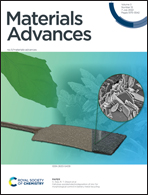Synergy of backbone and end-group engineering for efficient non-fused-ring asymmetric electron acceptor-based organic solar cells†
Abstract
Silole-based building blocks have been used to construct simple non-fused-ring electron acceptors (EAs) due to their improved packing ability and high charge mobility. However, most of these EAs have an A–D′–D–D′–A framework with three symmetric central units and exhibit lower power conversion efficiency (PCE) in organic solar cells (OSCs). In order to further simplify the molecular framework and get an improved PCE, in this work, two silole-based non-fused-ring small-molecule electron acceptors (EAs) of DTS26-IT-4F and DTS26-IT-4Cl were designed and synthesized with an A–D–D′–A backbone, in which a dual electron-donating D–D′ assembly of dithienosilole (DTS) and asymmetric iso-octoxy indenothiophene (IT) is employed as a central building block. At the same time, the electronic properties, charge transport, and film morphology can be precisely tuned by modifying the end groups. Due to the synergistic effect of asymmetric D–D′ combination, both EAs exhibit a good planar molecular backbone and a large dipole, which result in an improved molecular aggregation. Meanwhile, DTS26-IT-4Cl with chlorinated end groups and larger dipole moments exhibited lower LUMO energy levels. An outstandingly boosted PCE of 11.00% with a high open-circuit voltage of 0.878 V was achieved with the DTS26-IT-4Cl-based binary OSCs using polymer PM6 as the donor material. This work indicates that the asymmetric D–D′ assembly along with regulation of end-group engineering is a promising central building block to obtain high-performance EAs by their synergy.



 Please wait while we load your content...
Please wait while we load your content...